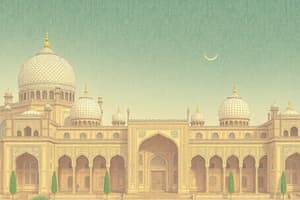Podcast
Questions and Answers
What are some natural resources found in Pakistan?
What are some natural resources found in Pakistan?
Natural gas, oil, coal, iron ore, copper, limestone, salt
Describe the agricultural products found in Bangladesh.
Describe the agricultural products found in Bangladesh.
Mango, bananas, coconut, jackfruit, oil, peat, natural gas, coal, limestone
What separates Nepal from its neighboring countries?
What separates Nepal from its neighboring countries?
Mount Everest
What are the primary food crops in Sri Lanka?
What are the primary food crops in Sri Lanka?
What makes up 40 percent of the land area in Maldives?
What makes up 40 percent of the land area in Maldives?
What type of forests are found in Nepal?
What type of forests are found in Nepal?
What are the two main industries that augment Maldives' economy?
What are the two main industries that augment Maldives' economy?
What does Punjab mean and why is it known for?
What does Punjab mean and why is it known for?
What is the staple food crop of Bangladesh?
What is the staple food crop of Bangladesh?
What are some of the products that India is one of the world's largest producers of?
What are some of the products that India is one of the world's largest producers of?
What natural resources does Afghanistan possess?
What natural resources does Afghanistan possess?
What is the most vital harvest in India?
What is the most vital harvest in India?
Flashcards are hidden until you start studying
Study Notes
Pakistan
- Located in southwestern Baluchistan plateau, with a mountainous north and the plains and valley of Punjab and Sindh
- Indus river and its tributaries support the farmlands of Pakistan
- Natural resources: natural gas, oil, low-graded coal, iron ore, copper, limestone, and salt
- Agricultural products: sugarcane, eggs, fruits, vegetable, milk, cotton, wheat, and mutton
Bangladesh
- Tropical climate with mangrove forests and fruit trees such as mango, bananas, coconut, and jackfruit
- Mineral resources: oil, peat, natural gas, coal, and limestone
- Rich in fauna and biodiversity
- Bay of Bengal is rich in oil
- Rice is the staple food crop, occupying more than 50% of the cultivated areas
- Jute is the "Golden fiber of Bangladesh" and a major source of foreign currency reserve
Nepal
- Part of the Himalayan mountain ranges
- Separated from neighboring countries by Mount Everest
- Plains cut by the Ganges river have swampy areas with deciduous forests, wild games, and medicinal herbs
- Farming is the main source of income
- Kathmandu Valley is a major cultivated area for rice, corn, wheat, and vegetables
Sri Lanka
- Terrain is largely flat and rolling with around 100 rivers
- Rainfall is crucial for farmers
- Main food crops: rice and tea, dependent on irrigation
- Other crops: fruits, vegetables, cocoa, cinnamon, citronella spices, and nuts
- Timber and fuel make up 40% of the country's land area
Maldives
- Archipelago of 1,190 coral islands clustered into 26 coral atolls or islets
- Covered with tropical plants and grasses
- Limited natural resources, except for rich water resources
- Economy is driven by fishing and tourism industries
Bhutan
- Small kingdom in the eastern Himalayas
- Agriculture-based economy
- Live in small villages
- Varied climate with abundance of natural resources
- Forests offer various species of mammals, birds, and medicinal plants
Afghanistan
- Landlocked country with nomadic herdsmen and farmers
- Isolated from the Arabian Sea by Pakistan and Iran
- Comprised of rugged mountain ranges, plains, and sandy desert
- Natural resources: gold, iron, copper, cobalt, and lithium
India
- Farmers depend on the monsoon
- Vast agricultural lands make India a competitor in international trade
- One of the world's largest producers of wheat, tea, milk, coffee, cotton, rice, fruits, nuts, and vegetables
- Rice is a vital harvest in the country
Studying That Suits You
Use AI to generate personalized quizzes and flashcards to suit your learning preferences.




